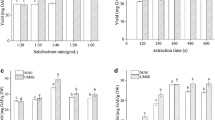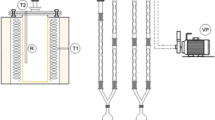Abstract
The saponins from the pericarps of Sapindus mukorossi Gaertn. (Sapindaceae) are attracting more and more attention because of their antimicrobial activity and their ability to act as a natural surfactant. However, the color of Sapindus pericarp extract is dark brown, which limits its application in some products. The present study aims to improve the color by adding hydrogen peroxide. An orthogonal L9 (3)4 test design was applied to optimize the decolorization parameters, including the amount of added hydrogen peroxide, time, temperature and pH. The extent of decolorization was up to 89.5 % below 80 °C within 80 min, using 2.5 % hydrogen peroxide at pH 6. The characteristics of Sapindus pericarp extract before and after bleaching were compared, including the antimicrobial and foaming performance, surface activities and detergency properties. There was no significant difference in either the diameters of the inhibition zone or the minimum inhibitory concentration against Candida albicans, Trichophyton rubrum and Pseudomonas aeruginosa (P < 0.05), while these parameters for C. albicans, T. rubrum and P. aeruginosa for the sample after decolorization were 22.33, 25.00, 15.33 mm and 0.91, 0.91, 13.03 mg/mL, respectively. The foamability of the Sapindus pericarp extract after decolorization was somewhat enhanced and the foam stability reduced (P < 0.05). There were no significant differences in values of the critical micelle concentration of the pericarp extract before and after decolorization. The detergency also remained at the same level. Our results show that the properties of the decolorized Sapindus pericarp extract were largely unchanged. This suggests that further development is worthwhile.


Similar content being viewed by others
References
Mahar KS, Rana TS, Ranade SA (2011) Molecular analyses of genetic variability in soap nut (Sapindus mukorossi Gaertn.). Ind Crops Prod 34:1111–1118
Sun JR, Cheng KC, Pan TY, Si XM (2002) A new acyclic sesquiterpene oligoglycoside from pericarps of Sapindus mukorossi. Chin Chem Lett 13:555–556
Roy D, Kommalapati RR, Mandava SS, Valsaraj KT, Constant WD (1997) Soil washing potential of a natural surfactant. Environ Sci Technol 31:670–675
Oda K, Matsuda H, Murakami T, Katayama S, Ohgitani T, Yoshikawa M (2000) Adjuvant and haemolytic activities of 47 saponins derived from medical and food plants. Biol Chem 381:67–74
Attele AS, Wu JA, Yuan CS (1999) Ginseng pharmacology. Multiple constituents and multiple actions. Biochem Pharmacol 58:1685–1693
Hamburger M, Slacanin I, Hostettmann K, Dyatmiko W, Sutarjadi (1992) Acetylated saponins with molluscicidal activity from Sapindus rarak: unambiguous structure determination by proton nuclear magnetic resonance and quantitative analysis. Phytochem Anal 3:231–237
Saxena D, Pal R, Dwivedi AK, Singh S (2004) Characterisation of sapindosides in Sapindus mukorossi saponin (reetha saponin) and quantitative determination of sapindosides. J Sci Ind Res 63:181–186
Sparg SG, Light ME, van Staden J (2004) Biological activities and distribution of plant saponins. J Ethnopharmacol 94:219–243
Sarin JL, Beri ML (1939) Extraction of saponin from soap nut. Ind Eng Chem 31:712–713
Sarin JL, Uppal MY (1941) Detergent value of soap nut powder. Ind Eng Chem 33:666–668
Aneja KR, Joshi R, Sharma C (2010) In vitro antimicrobial activity of Sapindus mukorossi and Emblica officinalis against dental caries pathogens. Ethnobot Leafl 14:402–412
Kommalapati RR, Valsaraj KT, Constant WD, Roy D (1997) Aqueous solubility enhancement and desorption of hexachlorobenzene from soil using a plant-based surfactant. Wat Res 31:2161–2170
Neamtu M, Siminiceanu I, Yediler A, Kettrup A (2002) Kinetics of decolorization and mineralization of reactive azo dyes in aqueous solution by the UV/H2O2 oxidation. Dyes Pigment 53:93–99
Mohey El Dein A, Libra JA, Wiesmann U (2003) Mechanism and kinetic model for decolorization of the azo dye reactive black 5 by hydrogen peroxide and UV radiation. Chemosphere 52:1069–1077
Wei FY, Zhang J, Xie H (2008) Determination of the content of total Sapindus-saponins. Nat Prod Res Dev 20:81–83
Ren HX, Wang CZ, Zhang DG (2011) Decolorization of Monascus fermentation products. China Brew 2:131–133
Okeke MI, Iroegbu CU, Eze EN, Okoli AS, Esimone CO (2001) Evaluation of extracts of the root of Landolphia owerrience for antibacterial activity. Ethnopharmacology 78:119–127
Aneja KR, Joshi R, Sharma C (2010) The antimicrobial potential of ten often used mouthwashes against dental caries pathogens. Jundishapur J Microbiol 23:15–27
Rios JL, Recio MC, Villar A (1980) Screening methods for natural products with antimicrobial activity: a review of the literature. Ethnopharmacology 23:127–149
Gunalan S, Sivaraj R, Rajendran V (2012) Green synthesized ZnO nanoparticles against bacterial and fungal pathogens. Progr Nat Sci Mat Int 22:693–700
Moroi Y, Mattura R (1988) Relationship between solubility and micellization of surfactants; micelle temperature range (MTR) instead of Krafft point. Chem Soc Japan 61:333–339
Yu W, Pan D, Zhang LP, Zhao XY, Zhao JL et al (2012) Liquid detergent for fabric. QB/T 1224–2012:1–7
Araújo da Fonseca FV, Yokoyama L, Teixeira LAC (2007) Influence of experiment variables on decoloration of azo reactive dyes by hydrogen peroxide and UV radiation. Environ Technol 28:1073–1078
Galindo C, Kalt A (1999) UV/H2O2 oxidation of azo dyes in aqueous media: evidence of a structure- degradability relationship. Dyes Pigment 42:199–207
Alaton IA, Balcioglu IA (2001) Photochemical and heterogeneous photocatalytic degradation of waste vinylsulphone dyes: a case study with hydrolyzed reactive black 5. J Photochem Photobiol 141:247–254
Eisner MD, Jeelani SAK, Bernhard LE, Windhab J (2007) Stability of foams containing proteins, fat particles and nonionic surfactants. Chem Eng Sci 62:1974–1987
Bals A, Kulozik U (2003) The influence of the pore size, the foaming temperature and the viscosity of the continuous phase on the properties of foams produced by membrane foaming. J Membr Sci 220:5–11
Fruhner H, Wantke KD, Lunkenheimer K (1999) Relationship between surface dilational properties and foam stability. Coll Surf 162:193–202
Wang LG, Yoon RH (2006) Stability of foams and froths in the presence of ionic and non-ionic surfactants. Miner Eng 19:539–547
Hakanpää J, Paananen A, Askolin S, Nakari-Setälä T, Parkkinen T, Penttilä W et al (2004) Atomic resolution structure of the HFBII hydrophobin a self-assembling amphiphile. J Biol Chem 279:534–539
Stubenrauch C, Miller R (2004) Stability of foam films and surface rheology: an oscillating bubble study at low frequencies. J Phys Chem 108:6412–6421
Wang LG, Yoon RH (2008) Effects of surface forces and film elasticity on foam stability. Int J Miner Process 85:101–110
Green AJ, Littlejohn KA, Hooley P, Cox PW (2013) Formation and stability of food foams and aerated emulsions: hydrophobins as novel functional ingredients. Curr Opin Colloid Interface Sci 18(4):292–301
Schmidt I, Novales B, Boué F, Axelos MAV (2010) Foaming properties of protein/pectin electrostatic complexes and foam structure at nanoscale. J Coll Interface Sci 345:316–324
Rosen MJ (2004) Surfactants and interfacial phenomena, 3rd edn. Wiley, London
Acknowledgments
The investigation reported in this article was supported by National Key Technology R&D Program in the 12th Five year Plan of China (No. 2012BAD36B02), Jiangsu province science and technology support program for social development (BE2012631), and the Priority Academic Program Development of Jiangsu Higher Education Institution (PAPD). The manuscript has been edited by International Science Editing.
Author information
Authors and Affiliations
Corresponding author
About this article
Cite this article
Wang, N., Wang, H., Weng, Z. et al. Decolorization of Sapindus Pericarp Extract by Hydrogen Peroxide and a Comparison of Basic Characteristics Before and After Decolorization. J Surfact Deterg 17, 1003–1011 (2014). https://doi.org/10.1007/s11743-014-1570-9
Received:
Accepted:
Published:
Issue Date:
DOI: https://doi.org/10.1007/s11743-014-1570-9




